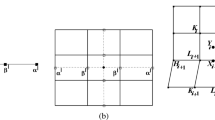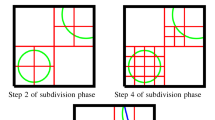Abstract
In [1], Srijuntongsiri and Vavasis propose the Kantorovich-Test Subdivision algorithm, or KTS, which is an algorithm for finding all zeros of a polynomial system in a bounded region of the plane. This algorithm can be used to find the intersections between a line and a surface. The main features of KTS are that it can operate on polynomials represented in any basis that satisfies certain conditions and that its efficiency has an upper bound that depends only on the conditioning of the problem and the choice of the basis representing the polynomial system.
This article explores in detail the dependence of the efficiency of the KTS algorithm on the choice of basis. Three bases are considered: the power, the Bernstein, and the Chebyshev bases. These three bases satisfy the basis properties required by KTS. Theoretically, Chebyshev case has the smallest upper bound on its running time. The computational results, however, do not show that Chebyshev case performs better than the other two.
Supported in part by NSF DMS 0434338 and NSF CCF 0085969.
Access this chapter
Tax calculation will be finalised at checkout
Purchases are for personal use only
Preview
Unable to display preview. Download preview PDF.
Similar content being viewed by others
References
Srijuntongsiri, G., Vavasis, S.A.: A condition number analysis of a line-surface intersection algorithm. SIAM Journal on Scientific Computing 30(2), 1064–1081 (2008)
Deuflhard, P., Heindl, G.: Affine invariant convergence theorems for Newton’s method and extensions to related methods. SIAM J. Numer. Anal. 16, 1–10 (1980)
Kantorovich, L.: On Newton’s method for functional equations (Russian). Dokl. Akad. Nauk SSSR 59, 1237–1240 (1948)
Srijuntongsiri, G., Vavasis, S.A.: Properties of polynomial bases used in a line-surface intersection algorithm (February 2009), http://arxiv.org/abs/0707.1515
Farin, G.: Curves and Surfaces for CAGD: A Practical Guide, 5th edn. Academic Press, London (2002)
Jónsson, G., Vavasis, S.: Accurate solution of polynomial equations using Macaulay resultant matrices. Mathematics of Computation 74, 221–262 (2005)
Author information
Authors and Affiliations
Editor information
Editors and Affiliations
Rights and permissions
Copyright information
© 2010 Springer-Verlag Berlin Heidelberg
About this paper
Cite this paper
Srijuntongsiri, G., Vavasis, S.A. (2010). Properties of Polynomial Bases Used in a Line-Surface Intersection Algorithm. In: Wyrzykowski, R., Dongarra, J., Karczewski, K., Wasniewski, J. (eds) Parallel Processing and Applied Mathematics. PPAM 2009. Lecture Notes in Computer Science, vol 6067. Springer, Berlin, Heidelberg. https://doi.org/10.1007/978-3-642-14390-8_38
Download citation
DOI: https://doi.org/10.1007/978-3-642-14390-8_38
Publisher Name: Springer, Berlin, Heidelberg
Print ISBN: 978-3-642-14389-2
Online ISBN: 978-3-642-14390-8
eBook Packages: Computer ScienceComputer Science (R0)




